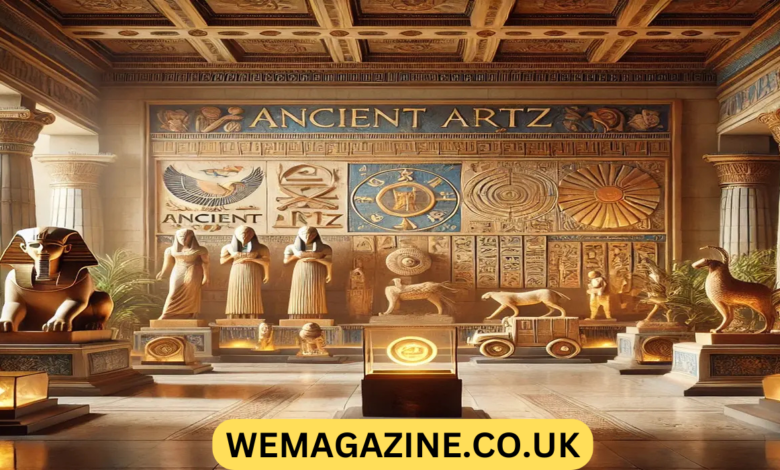Exploring Ancient Artz: A Journey Through Time, Techniques, and Cultural Significance

Introduction: The Timeless Allure of Ancient Artz
Ancient art is more than mere aesthetic appeal; it’s a window into our past, a testament to human ingenuity, belief systems, and cultural evolution. Through centuries, “ancient artz” has transcended time, influencing modern creative expression and providing insights into the lives and thoughts of people from early civilizations. Whether through the powerful stone carvings of Mesopotamia or the delicate pottery of ancient Greece, ancient art represents the essence of our cultural and artistic heritage. This article will guide you through the vast world of ancient art, exploring its defining characteristics, the artists’ techniques, and the lasting impact of these creations on contemporary art and culture.
Understanding the Foundations of Ancient Artz
Ancient art is diverse and covers many forms, from sculpture and painting to pottery and metalwork. Rooted in prehistoric times, each civilization had unique styles and techniques shaped by its environment, beliefs, and available resources. The earliest forms of ancient art are believed to have been created during the Paleolithic era, with humans carving figures and painting images on cave walls to express their experiences and beliefs.
Ancient Artz became a language that early societies used to communicate. While many of these societies had no formal writing system, their art often served as a way to pass down stories, myths, and cultural knowledge. Symbols, colors, and motifs within the art gave these ancient creations deeper meaning, often reflecting the gods, nature, and the cycle of life and death. For example, in ancient Egypt, the pharaohs commissioned grand sculptures and frescoes to emphasize their divine connection and immortalize their rule.
The evolution of ancient art can also be traced through materials. Artists and artisans adapted to the materials around them, from the stone and clay of early Mesopotamia to the bronze and marble used in Greece and Rome. This adaptability helped ancient art flourish, resulting in masterpieces that have endured for millennia.
Fundamental Techniques in Ancient Artz: Sculpting, Pottery, and Painting
Ancient artists developed numerous techniques that became the foundation for art today. Sculpting, pottery, and painting were primary methods, with techniques often reflecting the tools and materials available. Each method had its cultural significance and was usually tied to religious or ceremonial purposes, emphasizing the role of art in daily life and spiritual practices.
Sculpting was one of the earliest and most revered forms of ancient art. Sculptors in Mesopotamia, Egypt, and Greece carved intricate statues and reliefs, often representing gods, kings, or mythological scenes. In Egypt, for example, carving monumental statues of pharaohs was linked to their belief in the afterlife, with the statues intended to serve as vessels for the deceased’s soul. On the other hand, Greek sculptors emphasized idealized human forms, celebrating beauty and proportion that remain influential in art and aesthetics.
Pottery was both an art and a functional craft. Ancient pottery, particularly from regions like Greece, was adorned with mythology and scenes of daily life. Greek pottery evolved to incorporate red and black figure techniques, creating distinctive designs that helped tell stories visually. In contrast, ancient Chinese pottery, particularly during the Tang Dynasty, was known for its vibrant glazes and patterns symbolizing good fortune and prosperity. Pottery often had a dual purpose: it was a vessel for storage and an object of artistic expression.
Painting, while less durable than other forms, was equally significant. Ancient wall paintings in Egyptian tombs and Roman villas reveal how early artists used pigments derived from natural minerals to create vibrant scenes. The Egyptians often painted with a symbolic color palette; for example, blue represented fertility and life, while black symbolized the fertile soil of the Nile. These paintings were not merely decorative; they were created with spiritual intentions, believed to protect the dead and guide them through the afterlife.
Cultural Significance of Ancient Artz Across Civilizations
Each ancient civilization used art not only as a form of expression but as a reflection of their cultural and spiritual values. For example, Egyptian art is renowned for strictly adhering to symbolic conventions. Hieroglyphics, paintings, and sculptures were meticulously crafted to honor gods and rulers, emphasizing an afterlife-centered culture.
Art in Mesopotamia had a different focus. Known as the “Cradle of Civilization,” Mesopotamian art was pragmatic and often commemorated warfare, power, and religious rituals. The Ziggurats, towering temple structures, are a prime example of art serving both functional and spiritual purposes, as they were believed to connect humans to the divine.
Ancient Greek art is synonymous with beauty, proportion, and the idealization of the human form. Greek artists introduced innovations in perspective, anatomy, and naturalistic detail that marked a shift toward realism, influencing Western art for centuries. Greek pottery, statues, and temples reflected the values of democracy, philosophy, and the celebration of human achievement.
In Asia, ancient art took on a more introspective tone. Chinese art, particularly from the Han and Tang dynasties, often focused on themes of nature, harmony, and spirituality. Japanese art, influenced by Buddhism, showcased a minimalist approach, emphasizing simplicity and nature’s beauty.
The Enduring Legacy of Ancient Artz on Modern Art and Culture
Ancient art has left a lasting impression on modern art and architecture. The emphasis on symmetry, balance, and form seen in ancient Greek sculptures is echoed in the works of Renaissance and neoclassical artists like Michelangelo and Bernini. In modern times, ancient techniques and styles continue to inspire artists seeking a connection to tradition.
The influence of ancient art can also be seen in contemporary architecture. Columns, pediments, and proportional building designs directly contradict Greek and Roman architectural principles. Ancient Egyptian motifs, such as the iconic lotus and papyrus, also appear in Art Deco designs, revealing how ancient aesthetics persist in modern decorative arts.
In popular culture, ancient art is a foundation for storytelling and world-building. Movies, video games, and literature frequently draw on ancient Egyptian and Greek mythology, visually and thematically influenced by these early civilizations. Ancient artifacts, like Greek amphoras or Egyptian masks, continue to captivate audiences in museums worldwide, allowing modern viewers to connect with humanity’s artistic beginnings.
Preserving and Studying Ancient Artz in the Modern World
Preserving and studying ancient art have become critical for understanding human history. Archaeologists, historians, and art conservators work tirelessly to uncover and protect ancient sites and artifacts. With advancements in technology, researchers can now analyze pigments, materials, and structural details of ancient artworks, gaining insights into techniques and the cultural contexts of these creations.
Modern institutions and museums play a crucial role in keeping ancient art accessible to the public. The Louvre, the British Museum, and the Metropolitan Museum of Art house some of the most celebrated collections of ancient art, each offering visitors a glimpse into the lives of early civilizations. Conservation efforts, including climate-controlled environments and digital restoration, ensure that future generations can admire these priceless artifacts.
Efforts to repatriate artifacts to their countries of origin have also intensified, highlighting a broader discussion about cultural ownership and heritage. Ancient art, after all, belongs to humanity as a whole, reflecting our shared history and the diversity of our artistic achievements.
Conclusion: The Timeless Impact of Ancient Artz on Humanity
Ancient art remains a testament to human creativity, spirituality, and resilience. These works serve as more than historical artifacts; they are a bridge to our past, offering insights into the beliefs, values, and innovations that shaped early civilizations. From the intricate hieroglyphics of Egypt to the idealized sculptures of Greece, ancient art continues to inspire and inform the art and culture of today.
When we explore ancient art, we appreciate its beauty and craftsmanship and honor our ancestors’ enduring legacy. This timeless appeal ensures that ancient art will remain an essential part of our cultural heritage, connecting us to a distant past and reminding us of the universal human desire to create and communicate through art.




